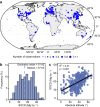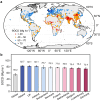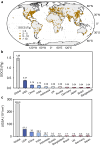Global distribution of surface soil organic carbon in urban greenspaces
- PMID: 38280879
- PMCID: PMC11258340
- DOI: 10.1038/s41467-024-44887-y
Global distribution of surface soil organic carbon in urban greenspaces
Abstract
Urban greenspaces continue to grow with global urbanization. The global distribution and stock of soil organic carbon (SOC) in urban greenspaces remain largely undescribed and missing in global carbon (C) budgets. Here, we synthesize data of 420 observations from 257 cities in 52 countries to evaluate the global pattern of surface SOC density (0-20 cm depth) in urban greenspaces. Surface SOC density in urban greenspaces increases significantly at higher latitudes and decreases significantly with higher mean annual temperature, stronger temperature and precipitation seasonality, as well as lower urban greenness index. By mapping surface SOC density using a random forest model, we estimate an average SOC density of 55.2 (51.9-58.6) Mg C ha-1 and a SOC stock of 1.46 (1.37-1.54) Pg C in global urban greenspaces. Our findings present a comprehensive assessment of SOC in global urban greenspaces and provide a baseline for future urban soil C assessment under continuing urbanization.
© 2024. The Author(s).
Conflict of interest statement
The authors declare no competing interests.
Figures




References
-
- Liu X, et al. High-spatiotemporal-resolution mapping of global urban change from 1985 to 2015. Nat. Sustainability. 2020;3:564–570. doi: 10.1038/s41893-020-0521-x. - DOI
-
- Churkina G. The role of urbanization in the global carbon cycle. Front. Ecol. Evol. 2016;3:144. doi: 10.3389/fevo.2015.00144. - DOI
-
- Lal, R. & Augustin, B. Carbon sequestration in urban ecosystems.(Springer Science & Business Media, 2011).
Grants and funding
LinkOut - more resources
Full Text Sources
Research Materials

